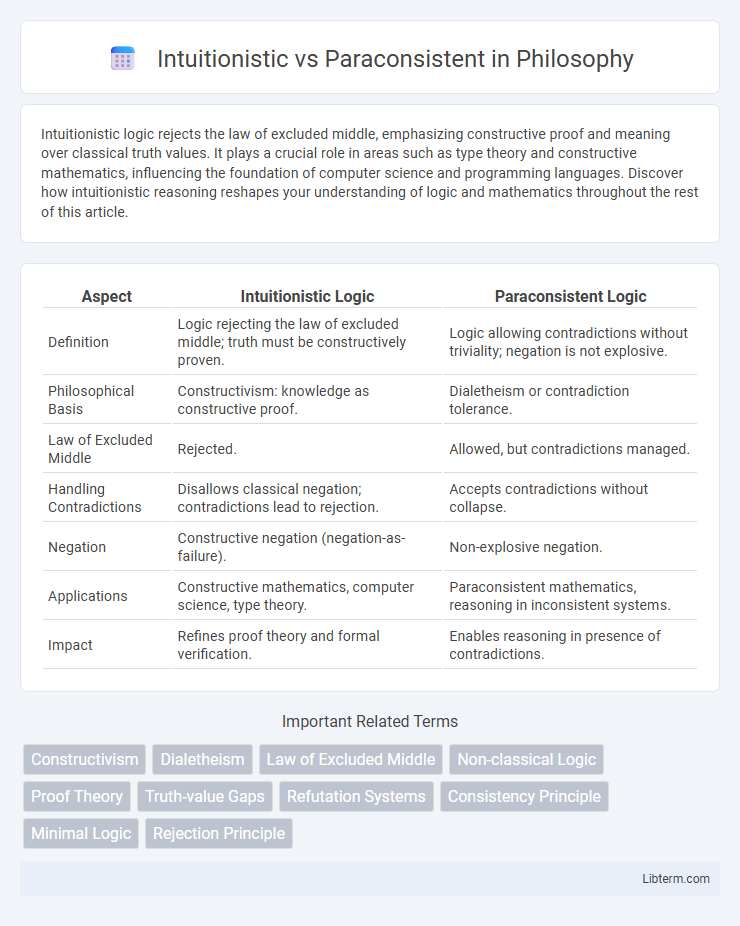Intuitionistic logic rejects the law of excluded middle, emphasizing constructive proof and meaning over classical truth values. It plays a crucial role in areas such as type theory and constructive mathematics, influencing the foundation of computer science and programming languages. Discover how intuitionistic reasoning reshapes your understanding of logic and mathematics throughout the rest of this article.
Table of Comparison
| Aspect | Intuitionistic Logic | Paraconsistent Logic |
|---|---|---|
| Definition | Logic rejecting the law of excluded middle; truth must be constructively proven. | Logic allowing contradictions without triviality; negation is not explosive. |
| Philosophical Basis | Constructivism: knowledge as constructive proof. | Dialetheism or contradiction tolerance. |
| Law of Excluded Middle | Rejected. | Allowed, but contradictions managed. |
| Handling Contradictions | Disallows classical negation; contradictions lead to rejection. | Accepts contradictions without collapse. |
| Negation | Constructive negation (negation-as-failure). | Non-explosive negation. |
| Applications | Constructive mathematics, computer science, type theory. | Paraconsistent mathematics, reasoning in inconsistent systems. |
| Impact | Refines proof theory and formal verification. | Enables reasoning in presence of contradictions. |
Introduction to Non-Classical Logics
Intuitionistic logic rejects the law of excluded middle, emphasizing constructivist proof techniques where the truth of a statement must be explicitly demonstrated. Paraconsistent logic allows contradictory statements to coexist without entailing triviality, effectively managing inconsistency in knowledge bases. Both are central to non-classical logics, expanding classical logic frameworks to address limitations like indeterminacy and contradiction.
Defining Intuitionistic Logic
Intuitionistic logic, rooted in constructivist philosophy, rejects the law of the excluded middle, emphasizing proofs that constructively demonstrate the truth of a proposition rather than relying on classical bivalence. It contrasts with paraconsistent logic by maintaining consistency and avoiding triviality, ensuring no statement and its negation can both be true. Intuitionistic logic's semantics is typically modeled by Heyting algebras or Kripke frames, highlighting its foundation on provability and constructive reasoning.
Understanding Paraconsistent Logic
Paraconsistent logic challenges the classical principle of non-contradiction by allowing contradictory statements to coexist without triviality, enabling reasoning in inconsistent but non-explosive systems. Unlike intuitionistic logic, which restricts the law of excluded middle and emphasizes constructivist proof, paraconsistent logic provides a framework to handle and reason about contradictions directly. This approach is crucial in fields like knowledge representation, artificial intelligence, and database theory, where inconsistent information must be processed without degeneration into logical chaos.
Core Principles and Differences
Intuitionistic logic, founded on the rejection of the law of excluded middle, emphasizes constructive proof, requiring that the truth of a statement be explicitly demonstrated. Paraconsistent logic, by contrast, tolerates contradictions without collapsing into triviality, allowing for the coexistence of contradictory statements without invalidating the entire system. Core differences stem from intuitionistic logic's insistence on proof construction and paraconsistent logic's capacity to manage and reason within inconsistent information.
Historical Background and Origins
Intuitionistic logic emerged in the early 20th century from the work of mathematician L.E.J. Brouwer, emphasizing constructivist approaches to mathematical proof and rejecting the law of excluded middle. Paraconsistent logic developed later in the mid-20th century as a response to classical logic's inability to handle contradictions without triviality, with key contributions from Newton da Costa and Graham Priest. Both frameworks arose from foundational concerns--intuitionism addressing the nature of mathematical truth and paraconsistency challenging the principle of explosion in classical systems.
Applications in Mathematics and Computer Science
Intuitionistic logic finds extensive applications in constructive mathematics, type theory, and proof verification within computer science, enabling the extraction of algorithms from proofs through the Curry-Howard correspondence. Paraconsistent logic addresses inconsistencies in databases, knowledge representation, and software verification, allowing systems to tolerate contradictions without collapsing into triviality. Both logics are crucial in formal methods, with intuitionistic logic supporting constructive proofs and paraconsistent logic facilitating reasoning under faulty or incomplete information.
Logical Implications and Reasoning
Intuitionistic logic rejects the law of the excluded middle, emphasizing constructive proof and intuition-based reasoning where a statement is only true if there is a direct proof. Paraconsistent logic allows for contradictions without collapsing into triviality, enabling reasoning in systems where inconsistencies exist by controlling the implications to prevent explosion. Logical implications in intuitionistic frameworks require constructive evidence, while paraconsistent reasoning manages conflicting information by modifying inference rules to avoid invalid conclusions.
Semantic Interpretations
Intuitionistic logic is grounded in constructive semantics, where propositions are interpreted through the existence of explicit proofs rather than classical truth values, emphasizing verification over truth. Paraconsistent logic employs non-classical semantics that tolerate contradictions without trivialization, enabling reasoning in the presence of conflicting information by rejecting the principle of explosion. These semantic interpretations reflect distinct approaches to truth: constructive proof in intuitionism and controlled inconsistency in paraconsistency, each shaping their respective formal systems and applications in reasoning under uncertainty.
Advantages and Limitations
Intuitionistic logic excels in providing a constructive framework that ensures proof-based truth, making it valuable in areas like programming language semantics and type theory, but it limits classical reasoning by rejecting the law of excluded middle. Paraconsistent logic allows reasoning in the presence of contradictions without collapsing into triviality, offering advantages in fields like knowledge representation and fault-tolerant systems, yet it can complicate inference by permitting conflicting information. Both logics extend classical logic boundaries but introduce trade-offs between consistency control and expressive power essential for specific computational and philosophical applications.
Conclusion and Future Directions
Intuitionistic logic rejects the law of excluded middle, emphasizing constructive proofs and maintaining consistency, while paraconsistent logic allows contradictions without collapse, addressing inconsistencies in real-world data. Future research aims to integrate these frameworks to handle incomplete and contradictory information more effectively, enhancing automated reasoning and knowledge representation systems. Exploring hybrid models and applications in artificial intelligence and computer science promises advancements in logical inference and decision-making under uncertainty.
Intuitionistic Infographic

 libterm.com
libterm.com